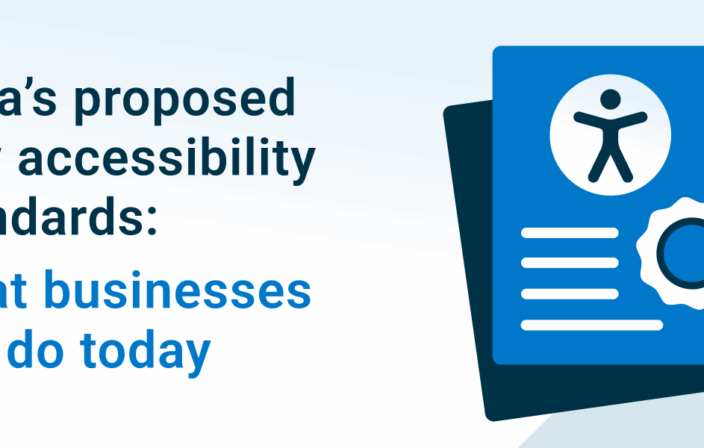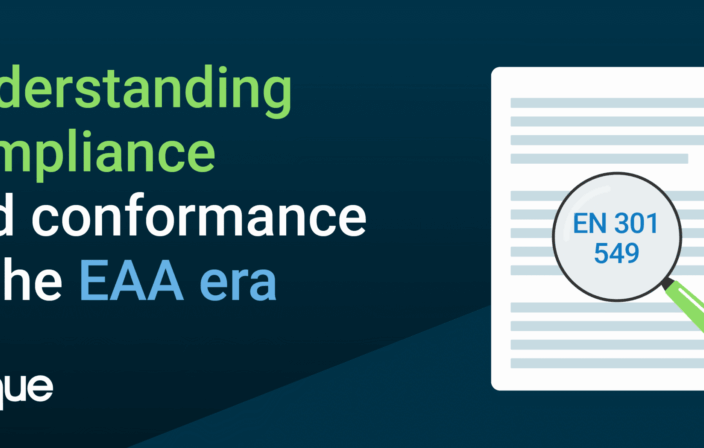[Editors note: An updated version of this infographic is available at https://accessibility.deque.com/essential-guide-digital-accessibility]
A whopping 57 million Americans are living with disabilities, and many of them find web browsing difficult. Digital accessibility is continuously evolving to meet the demands of this growing demographic. Don’t get left behind! Take a look at our cool infographic – the Essential Guide to Digital Accessibility – for more information, and learn how Deque can help you manage risk with the right tools. Plus, check out our accessible HTML version below the infographic, or download the essential guide for your convenience.

Infographic – The Essential Guide to Digital Accessibility
57 Million Americans
are living with a disability.
That’s more than the populations of California and New York combined.
And of those…
- 2.17 million surf the web on a regular basis.
- 1.15 million find web browsing challenging.
- An estimated 9 out of 10 websites are NOT accessible
Disabilities that affect web browsing
- Visual 3.2 million
- Hearing 3.9 million
- Cognitive Mental 7.9 million
- Ambulatory 9.8 million
What is digital accessibility?
Digital accessibility is creating a secure technological system for digital
components such as: mobile applications, digital documents, website pages.
So that everyone can have the same user experience when they access these types of digital components.
It’s a growing market.
As a global, emerging market, the disability community is an increasingly powerful demographic, representing $3 trillion in disposable income.
Accessibility increases Findability
Accessibility techniques increase the findability of web pages by exposing content to search engines, both internally (within a website) and externally (across the World Wide Web). For example:
- Alternative text for images and multimedia is available to search engines
- Most search engines access text and not images
- For some search engines, text marked as a heading carries more weight
- than regular text
- Some search engines are unable to access some code-generated content such as mouse-overs
Assistive Technology can help!
Navigating the web without sight, hearing, or hands can be a challenge, but is possible with Assistive Technology.
- Screen Readers: Help people hear content of a website (disability – blind or low vision)
- Web Application: Allows a website to be used without a mouse (disability – limited mobility)
- Videos: Are captioned and have transcripts available (disability – hearing impaired)
- PDFs: Can be downloaded and computer can read content out-loud (disability – blind or low vision)
What makes a website accessible?
While I believe passionately that there is a strong business case for websites to be accessible, in the end it is a civil rights issue. The Internet is too valuable a resource to deprive people of the ability to utilize it.
Preety Kumar, Deque CEO
3 Reasons to ACT!
- There is a clear precedent that the ADA and other regulations require websites to be accessible.
- The accelerating pace of structured settlements & litigation is creating a growing amount of precedent.
- A small amount of preparedness can save a meaningful amount of expense, effort and stress for the organization.
Web Content Accessibility Guidelines
W.C.A.G. is a series of web accessibility guide-lines published by the W3C’s Web Accessibility Initiative. It’s the standard rule set that defines what exactly makes a website accessible.
On average, people with disabilities spend $45 billion a year
Oops! Sorry but you can not access this page!
Are you willing to lock out 20% of the potential visitors to your site?
How to Approach Accessible Compliance
There are two choices to make when facing accessible compliance.
Decide which choice is right for you and your business.
1. Proactive Preparation
Steps to Manage Proactively:
- Fix high priority issues based on transaction paths.
Determine what the most important tasks are that your site users perform, and the individual clicks that comprise the tasks. - Monitor the website
- Raise awareness with key stakeholders
- Focus on front line staff.
Example: A single phone call that was not handled with basic competency when the discussion turned to accessibility of the company’s website was the trigger that started a formal government inquiry - Have a conformance statement.
AKA “A Golden Shield” – document from a trusted third party that states the plan & commitment the business has around accessibility.
2. Reactive Response
Steps to Manage Proactively:
- Sit down at the table w/the organization bringing the complaint to your company.
- Get a specialist involved.
Someone w/experience, don’t spend 7-figures trying to handle it internally! - Build internal knowledge w/2 teams:
- development
- front line customer service.
- Invest in tools.
- Help in building/revision of accessible sites
- Ensure accessibility over time
How Proactive Preparation Benefits Your Business
- Less Expensive
- Control of focus & investment
- Good business
- Provides a shield to help manage further inquiry
- Enhanced SEO benefits
A Checklist for Your Company
Does your company:
- Regularly evaluate your website for accessibility & provide reports to key stakeholders that track WCAG compliance?
- Evaluate electronic documents for accessibility?
- Train & refresh both development and front line staff on relevant aspects of the accessibility program?
- Have an internal owner for accessibility who keeps the roadmap for future enhancements?



